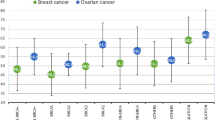Abstract
Aim:
This study aimed to analyze whether the occurrence of both breast and ovarian cancer in a woman serves as a marker for BRCA gene mutations.
Material and methods:
This population-based study included 256 women in western Sweden who developed both invasive breast and ovarian tumors between 1958 and 1999. Archival paraffin tissue blocks of their tumors were retrieved for DNA-extraction to analyze the founder mutation, BRCA1 c.3171_3175dup (c.3171ins5), which is most common in this geographic area and four other common Scandinavian BRCA1 gene mutations and one BRCA2 mutation. Together, account these mutations for approximately 75% of the BRCA1/2 gene mutations in the clinical unit.
Results:
Ninteen percent (95% confidence interval (CI) 14–24%) of the women carried one of the analyzed BRCA1 gene mutations but none of the women were positive for the analyzed BRCA2 mutation. One-third of the women with both tumors before age 60 were mutation carriers. BRCA1 c.3171_3175dup (c.3171ins5) constituted 84% of all identified mutations. Although the majority of breast cancers were invasive ductal and atypical medullary types, a variety of other breast malignancies were seen among mutation carriers. Serous ovarian carcinomas predominated among ovarian tumors. A variety of other ovarian tumors, including three granulosa-theca cell tumors, were also observed among mutation carriers.
Conclusions:
The occurrence of both breast and ovarian cancer in a woman is associated with a high likelihood of a constitutional BRCA1 mutation. These women and their families might therefore be considered for mutation screening after appropriate genetic counselling.
Similar content being viewed by others
References
Peto J, Collins N, Barfoot R et al (1999) Prevalence of BRCA1 and BRCA2 gene mutations in patients with early-onset breast cancer. J Natl Cancer Inst 91(11):943–949
Thorlacius S, Struewing JP, Hartge P et al (1998) Population-based study of risk of breast cancer in carriers of BRCA2 mutation. Lancet 352(9137):1337–13379
Neuhausen SL (1999) Ethnic differences in cancer risk resulting from genetic variation. Cancer 86(Suppl 11):2575–2582
Tobias DH, Eng C, McCurdy LD et al (2000) Founder BRCA 1 and 2 mutations among a consecutive series of Ashkenazi Jewish ovarian cancer patients. Gynecol Oncol 78(2):148–151
Loman N, Johannsson O, Kristoffersson U, Olsson H, Borg A (2001) Family history of breast and ovarian cancers and BRCA1 and BRCA2 mutations in a population-based series of early-onset breast cancer. J Natl Cancer Inst 93(16):1215–1223
Hirsh-Yechezkel G, Chetrit A, Lubin F et al (2003) Population attributes affecting the prevalence of BRCA mutation carriers in epithelial ovarian cancer cases in israel. Gynecol Oncol 89(3):494–498
Johannsson O, Ostermeyer EA, Hakansson S et al (1996) Founding BRCA1 mutations in hereditary breast and ovarian cancer in southern Sweden. Am J Hum Genet 58(3):441–450
Einbeigi Z, Bergman A, Kindblom LG et al (2001) A founder mutation of the BRCA1 gene in Western Sweden associated with a high incidence of breast and ovarian cancer. Eur J Cancer 37(15):1904–1909
Bergman A, Flodin A, Engwall Y et al (2005) A high frequency of germline BRCA1/2 mutations in western Sweden detected with complementary screening techniques. Fam Cancer 4:89–96
Bergman A, Einbeigi Z, Olofsson U et al (2001) The western Swedish BRCA1 founder mutation 3171ins5; a 3.7 cM conserved haplotype of today is a reminiscence of a 1500-year-old mutation. Eur J Hum Genet 9(10):787–793
Bergfeldt K, Rydh B, Granath F et al (2002) Risk of ovarian cancer in breast-cancer patients with a family history of breast or ovarian cancer: a population-based cohort study. Lancet 360(9337):891–894
Einbeigi Z, Meis-Kindblom JM, Kindblom LG, Wallgren A, Karlsson P (2002) Clustering of individuals with both breast and ovarian cancer—a possible indicator of BRCA founder mutations. Acta Oncol 41(2):153–157
World Health Organisation (1957) ICD-7. International classification of diseases, injuries and causes of death. 1955 revision, Geneva
den Dunnen JT, Antonarakis SE (2000) Mutation nomenclature extensions and suggestions to describe complex mutations: a discussion. Hum Mutat 15(1):7–12
Deffenbaugh AM, Frank TS, Hoffman M, Cannon-Albright L, Neuhausen SL (2002) Characterization of common BRCA1 and BRCA2 variants. Genet Test 6(2):119–121
Welcsh PL, King MC (2001) BRCA1 and BRCA2 and the genetics of breast and ovarian cancer. Hum Mol Genet 10(7):705–713
Williams C, Pontén F, Moberg C et al (1999) A high frequency of sequence alterations is due to formali fixation of archival specimens. Am J Pathology 155:1467–1471
Bergfeldt K, Silfversward C, Einhorn S, Hall P (2000) Overestimated risk of second primary malignancies in ovarian cancer patients. Eur J Cancer 36(1):100–105
Johannsson OT, Idvall I, Anderson C et al (1997) Tumour biological features of BRCA1-induced breast and ovarian cancer. Eur J Cancer 33(3):362–371
Malander S, Ridderheim M, Masback A et al (2004) One in 10 ovarian cancer patients carry germ line BRCA1 or BRCA2 mutations: results of a prospective study in Southern Sweden. Eur J Cancer 40(3):422–428
Sarantaus L, Auranen A, Nevanlinna H (2001) BRCA1 and BRCA2 mutations among Finnish ovarian carcinoma families. Int J Oncol 18(4):831–835
King MC, Marks JH, Mandell JB (2003) Breast and ovarian cancer risks due to inherited mutations in BRCA1 and BRCA2. Science 302(5645):643–646
Bergthorsson JT, Ejlertsen B, Olsen JH et al (2001) BRCA1 and BRCA2 mutation status and cancer family history of Danish women affected with multifocal or bilateral breast cancer at a young age. J Med Genet 38(6):361–368
Margolin S, Werelius BF, Fornander T, Lindblom A (2004) BRCA1 mutations in a population-based study of breast cancer in Stockholm County. Genet Test 8:127–132
Dørum A, Hovig E, Trope C, Inganas M, Moller P (1999) Three per cent of Norwegian ovarian cancers are caused by BRCA1 1675delA or 1135insA. Eur J Cancer 35(5):779–781
Acknowledgments
Supported by grants from the Swedish State under the ALF agreement, the King Gustaf V: s Jubilee Clinic Cancer Research Foundation and Assar Gabrielsson Foundation for Clinical Research.
Author information
Authors and Affiliations
Corresponding author
Rights and permissions
About this article
Cite this article
Einbeigi, Z., Bergman, A., Meis-Kindblom, J.M. et al. Occurrence of both breast and ovarian cancer in a woman is a marker for the BRCA gene mutations: a population-based study from Western Sweden. Familial Cancer 6, 35–41 (2007). https://doi.org/10.1007/s10689-006-9101-0
Received:
Accepted:
Published:
Issue Date:
DOI: https://doi.org/10.1007/s10689-006-9101-0




